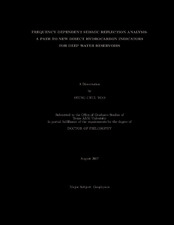| dc.description.abstract | To better study frequency related effects such as attenuation and tuning, we developed a frequency dependent seismic reflection analysis. Comprehensive tests on full waveform synthetics and observations from the Teal South ocean bottom seismic (OBS) data set confirmed that normal moveout (NMO) stretch could distort both frequency and amplitude information severely in shallow events and far offset traces. In synthetic tests, our algorithm recovered amplitude and frequency information ac-curately. This simple but robust target oriented NMO stretch correction scheme can be used on top of an existing seismic processing flow for further analyses. By combining the NMO stretch correction, spectral decomposition, and crossplots of am-plitude versus offset (AVO) attributes, we tested the frequency dependent workflow over Teal south and Ursa field data sets for improved reservoir characterization. As expected from NMO stretch characteristics, low frequencies have been less affected while mid and high frequency ranges were affected considerably. In seismic attribute analysis, the AVO crossplots from spectrally decomposed prestack data confirmed the improved accuracy and effectiveness of our workflow in mid and high frequency regions. To overcome poor spectral decomposition results due to low signal to noise ratio (S/N) in the Teal South application, we also implemented a substack scheme that stacks adjacent traces to increase S/N ratio while reducing the amount of data to process and increasing the accuracy of the spectral decomposition step. Synthetic tests verified the effectiveness of this additional step. An application to the Ursa, Gulf of Mexico, deep water data set showed significant improvement in high frequency data while correcting biased low frequency information. | en |


